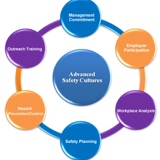Information
-
Client Name
-
Location
-
Job site photo
-
Conducted on
-
Conducted by
Site Inspection/Site Visit
Client Contact
-
Client Contact Name
-
Title
-
Contact #
General Safety and Health Provisions
-
Safety and Training Education: <br>Is each employee instructed in the recognition and avoidance of unsafe conditions and the regulations applicable to their work environment to control or eliminate any hazards or other exposure to illness or injury? 1926.21(b)(2)
-
Harmful Substances: <br>Are employees who are required to handle or use poisons, caustics, and other harmful substances instructed in their safe handling and use, and made aware of the potential hazards, personal hygiene, and personal protective measures? 1926.21(b)(3)
-
Confined Space/Enclosed Space: <br>Are employees who are required to enter confined or enclosed spaces instructed as to the nature of the hazards involved, the necessary precautions to be taken, and in the use of protective and emergency equipment? 1926.21(b)(6)(i)
-
Housekeeping: <br>Is form and scrap lumber with protruding nails and all other debris kept cleared from work areas, passageways, and stairs? 1926.25(a)
Personal Protective and Life Saving Equipment
-
Head Protection: <br>Are protective helmets (hard hats) worn at all times where there is a possible danger of head injury from impact, falling or flying objects, or electrical shock and burns? 1926.100
-
Hearing Protection:<br> Are ear protection devices provided and used wherever it is not feasible to reduce noise levels or where a deviation to exposures levels specified in Table D-2, Permissible noise exposure in 1926.52 exist? 1926.101
-
Eye and Face Protection: <br>Are employees provided with and use eye and face protection when machines or operations present potential eye or face injury from physical, chemical, or radiation agents? 1926.102
-
Is foot protection needed? 1926.96<br>
-
Selection, Issuance, Use and Care of Respirators: <br>Are employers provided with and use appropriate respiratory protective devices in emergencies or when controls required by Subpart D of this part either fail or are inadequate to prevent harmful exposure? 1926.103(a)(1)
-
Working Over or Near Water: <br>Are employees working over or near water provided with and use U.S. Coast Guard-approved life jacket or buoyant work vests and are ring buoys with at least 90 feet of line and at least one lifesaving skiff provided? 1926.103
Fire Protection
-
Is firefighting equipment conspicuously located? 1926.150(a)(3)<br>
-
Is firefighting equipment periodically inspected and maintained in operating condition? 1926.150(a)(4)<br>
-
Is firefighting equipment selected and provided according to the listed requirements? 1926.150(c)<br>
-
Has an educational program to familiarize employers with the general principles of fire extinguishers use and the hazards involved been provided? 1910.150(c)(xi)<br>
-
Flammable and Combustible Liquids: Are all flammable and combustible liquids stored and handled in approved containers and portable tanks? 1926.152(a)(1)<br>
Tools, Hand and Power
-
General Requirements: Are hand and power tools furnished by employer or employee maintained in a safe condition? 1926.300(a)<br>
-
Are power tools, belts, gears, shafts, pulleys, sprockets, spindles, drums, fly wheels, and chains properly guarded? 1926.300 (b)(1) & (2)<br>
-
Power-Operated hand tools: Are electric power operated tools equipped with proper ground or are they double insulated? 1926.302(a)<br>
-
Have all employees who operate power actuated tools been trained in the use of the particular tool they use? 1926.302(e)(1)<br>
-
Woodworking tools: Do all portable circular saws have a guard above the base plate and a guard below the base plate that will automatically and instantly return to the covering position when the saw is withdrawn from the work? 1926.304(d)<br>
-
Do all circular saws have an exhaust hood or a guard to prevent accidental contact with the saw blade if there is a possibility of contact either beneath or behind the table? 1926.304(f) ANSI 01.0-1926 Section 4.1.1<br>
-
Do hand-fed circular rip saws have an upper blade guard? 1926.304(f) ANSI 01.0-1926 Section 4.1.2(a)<br>
-
Do hand-fed circular rip saws have a spreader? 1926.304(f) ANSI 01-1-1926 Section 4.1.2(b)<br>
-
Do hand-fed circular rip saws have non-kickback fingers or dogs? 1926.304(f) ANSI 01-1-1926 Section 4.1.2<br>
Electrical
-
General Requirements: Does the employer examine all electrical equipment to ensure that recognized electrical hazards (i.e. exposed live parts, splices in cords, missing ground pins, reverse polarity, etc.) are identified? 1926.403(b)(1)<br>
-
Are disconnecting means legibly marked to indicate purpose unless located so that purpose is evident? 1926.403(h)<br>
-
Are live electrical parts guarded against accidental contact? 1926.403(i)(2)<br>
-
Are ground fault circuit interrupters used to protect employees? 1926.404(b)(1)(i)<br>
-
If not is an assured equipment grounding program in place? 1926.404(b)(1)(iii)<br>
-
Are all 120-volt, single phase, 15-and 20-ampere receptacle outlets on construction sites, which are not a part of the permanent wiring of the building or structure and which are in use by employees, protected by a ground-fault circuit interrupter(s) GFCI? 1926.404(b)(1)(ii)<br>
-
Are outlet devices correctly matched with load being served? 1926.404(b)(2)<br>
-
Are all electrical circuits and equipment grounded? Is path to ground from circuits, equipment and enclosures permanent and continuous? 1926.404(f)(6)<br>
-
Are exposed noncurrent carrying metal parts of cord and plug-connected equipment grounded? 1926.404(f)(7)(iv) Are electrical extension cords of the three wire type? 1926.405(a)(2)(ii)(J)<br>
-
Are lamps for general illumination protected against breakage? 1926.405(a)(2)(ii)(E)<br>
-
Are flexible cords and cables protected from damage? 1926.405(a)(2)(ii)(l)<br>
-
Are conductors entering boxes, cabinets, or fittings protected from abrasion and do unused openings in cabinets, boxes and fittings have covers? 1926.405(b)(1)
-
Are all cabinets, cut out boxes, fittings, boxes, panel board enclosures, switches, circuit breakers, and switchboards located in wet or damp locations enclosed in weather proof enclosures? 1926.405(e)(1) and (2)
-
Are fixtures and receptacles in wet or damp locations identified for that purpose and installed so that water cannot enter? 1926.405(j)(1)(v) and (j)(2)(ii)
-
Safety related work practices: Are electrical cords or cables taken out of service when worn or frayed? 1926.416(e)(1)<br>
-
Are contractors/subcontractors (painters) using aluminum extension handles (or ladders) around electrical power lines?<br>
Fall Protection >6 Feet
-
When excavations, wells, shafts, pits, are not readily seen (shrubs, plants, etc.) are employees protected by guardrails, fences or barricades? 1926.501(b)(7)(i) and (iii)
-
General Requirements: Is walking/working surface strong enough to support employees and the work to be done? 1926.501(a)(2)<br>
-
Are employees on walking/working surfaces with unprotected sides and edges protected by guardrails, safety nets, or personal fall arrest systems? 1926.501(b)(1)<br>
-
Are employees who are constructing leading edges protected by guardrails, safety nets or personal fall arrest systems if feasible? (If not feasible, requirements of paragraph (k) of 1926.502 must be met) 1926.501(b)(2)(i)<br>
-
Is each employee in a hoist area protected by either guardrails or personal fall arrest system? 1926.501(b)(3)<br>
-
In hoisting areas where guardrails are used and guardrails are removed to facilitate landing of material and the employee must lean out over the edge or through the access opening, is that employee protected by a fall arrest system? 1926.501(b)(3)<br>
-
Are employees exposed to falling through holes (including skylights) protected by fall arrest systems, guardrails or covers? 1926.501(b)(4)(i)<br>
-
Are employees on walking/working surfaces protected from tripping or stepping into holes by covers? 1926.501(b)(4)(iii)<br>
-
Are employees on walking/working surfaces protected from objects falling through holes by covers? 1926.(b)(4)(iii)<br>
-
Are exposed employees working on the face of form work or reinforcing steel protected by fall arrest systems, safety nets, or positioning device systems? 1926.501(b)(5)<br>
-
Are employees working on ramps, runways or other walkways protected by guardrail systems? 1926.501(b)(6)<br>
Stairways and Ladders
-
General requirements: Is a ladder or stairway provided at all personnel points of access where there is a break in elevation of 19 inches or more? 1926.1051(a)<br>
-
Is there always at least one clear point of access between levels of a building or structure? 1926.1051(a)(3) & (4)<br>
-
Stairways: Is each stairway having four or more risers or rising mroe than 30 inches equipped with :(a): at least one handrail:(b):at least one stairrail system along each unprotected side or edge? 1926.1052(c)(1)<br>
-
Are there unprotected sides and edges of stairway landings provided with a guardrail system? 1926.1052(c)(12)<br>
-
Ladders: Are ladder rungs, cleats, and steps parallel, level and evenly spaced when the ladder is positioned for use? 1926.1053(a)(2)<br>
-
Does each stepladder have a metal spreader or locking device? 1926.1053(a)(8)<br>
-
Do portable ladders used for access to an upper landing surface have side rails that extend at least 3 feet above the landing? 1926.1053(b)(1)<br>
-
Do ladders that are used where the employee or the ladder could contact exposed energized parts have nonconductive side rails? 1926.1053(b)(12) (see 1926.951(c)(1) for exception)<br>
-
Are ladders periodically inspected by a competent person? 1926.1053(b)(15)<br>
-
Are portable ladders with structural defects marked as defective and withdrawn from service? 1926.1053(b)(16)<br>
-
Training Requirements: Have all employees been trained to recognize hazards related to ladders and stairways? 1926.1060(a)<br>
Occupational Health and Environmental Controls
-
Sanitation: Are potable (drinking) water and adequate toilet facilities available at the site? 1926.51<br>
-
<br>Illumination: Are employees provided with adequate lighting?<br>
-
Hazard Communication: Does the employer have any hazardous materials on site? If so, does the employer have a written HazCom program? 1926.59(e)(1)<br>
-
Does employer have a complete list of hazardous chemicals used on site at the worksite? 1926.59(e)(1)(i)<br>
-
Are containers of hazardous chemicals, labeled, tagged or marked? 1926.59(f)(1)<br>
-
Does the employer have an MSDS for each hazardous chemical on site? 1926.59(g)(1)<br>
-
Are MSDS available to employees in their work area? 1926.59(g)(8)<br>
-
Are employees trained in the hazards of chemicals in their work area? 1926.59(h)<br>
Excavations
-
General Requirements: Are all surface encumbrances that may create a hazard removed or supported as necessary to safeguard employees? 1926.651(a)<br>
-
Have all underground utility installations been located? 1926.651(b)(1), (2) and (3)<br>
-
In trenches more than 4 feet deep, are stairways, ladders or ramps located so that travel to them is no more than 25 feet? 1926.651(c)(2)<br>
-
<br>Are employees exposed to vehicular traffic wearing warning vests made of reflectorized or high visibility material? 1926.651(d)<br>
-
<br>Is a warning system such as barricades, hand or mechanical signals or stop logs used when mobile equipment approaches the edge of the excavation? 1926.651(f)<br>
-
<br>Are testing and controls used to prevent exposure to hazardous atmospheres? 1926.651(g)<br>
-
Are excavation or other materials kept at least 2 feet from the edge of excavations? 1926.651 (j)(2)<br>
-
Is the excavation inspected daily and after any hazard increasing occurrence by a competent person? 1926.651 (k)(1)<br>
-
Requirements for protective systems: Are employees in an excavation 5 feet deep or more, or with the potential for cave in, protected by an adequate protective system? 1926.652 (a)(1) Note: See appendices A, B, C, D, E, and F to this standard<br>
Corrective Action
-
Time for corrective action to be completed
-
Who is responsible for Corrective Action? Name and Title
-
Does client have any safety training needs?<br>
-
If so, what?
-
Safety Specialist Comments
-
Client Contact Signature
-
Safety Specialist Signature










